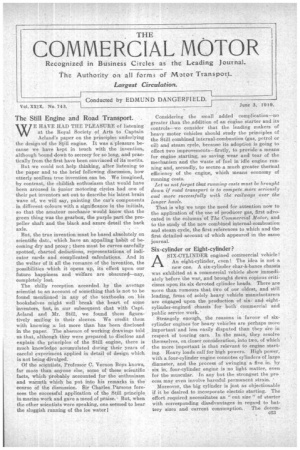The Still Engine and Road Transport.
Page 1

If you've noticed an error in this article please click here to report it so we can fix it.
WE HAVE HAD THE PLEASURE of listening at the Royal Society of Arts to Captain AcIand's paper on the principles underlying the design iof the Still engine. It was a pleasure because we have kept in touch with the invention, although bound down to secrecy for so long, and practically from the first have been convinced of its merits.
• But we could not help thinking, after listening to the paper and to the brief following discussion, how utterly soulless true invention can be. We imagined, ;by contrast, the childish enthusiasm that would have been aroused in junior motoring circles bad one of their pet inventors set out to describe his latest brain wave of, we will say, painting the car's components in different eolours with a significance in the initials, so that the amateur mechanic would know that the green thing was the gearbox, the purple part the propeller shaft and the black and azure detail the back axle.
But, the true invention must be based absolutely on scientific datc„ which have an appalling habit of becoming dry and prosy ; there must be curves carefully spotted, charted deductions, representations of indicator cards and complicated calculations. And in the welter of it all the romance of the invention, the possibilities which it opens up, its effect upon our future happiness and welfare are obscure-nay, completely lost. The chilly reception accorded by the average scientist to an account of something that is not to be found mentioned in any of the textbooks or( his bookshelves might well break the heart of some inventors, but, in our subsequent chat with Capt.. Acland and Mr. Still, we found them figuratively smiling in their sleeves. We credit theta with knowing a lot more than has been disclosed in the paper. The absence of working drawings told us that, although they were prepared to disclose and explain the principles of the Still engine, there is much knowledge accumulated during their years of careful experiment applied in detail of design which is not being divulged. Of the scientists, Professor C. Vernon Boys knows, far more than anyone else, some of these scientific facts, which, probably =counted for the enthusiasm and warmth which he put into his remarks in the course of the discussion. Sir Charles Parsons foresees the successful application of the Still principle. in marine work and gave a raced of praise.' But, when the other scientists were speaking, one seemed to hear the sluggish running of the ice water I Considering the small added complication—no greater than the addition of an. engine starter and its controls—we consider that the leading makers of heavy motor vehicles should study the principles of the Still combined internal-combustion (gas, petrol or oil) and steam cycle, because its adoption is going to effect two improvements—firstly, to provide a means for engine starting, so saving wear and tear of the mechanism and the waste. of fuel in idle engine running and, secondly, to secure a much greater thermal efficiency of the engine, which means economy of running costs.
Let us not forget that running costs must be brought down if road transport is to compete more seriously and more successfully with the railways over the longer hauls. That is why we urge the need for attention now to the application of the use of producer gas, first advocated in the columns' of The Commercial Motor, and to the study of the new combined internal-combustion and steam cycle, the first references to which and the first detailed account of which appeared in the same j ournal.






















